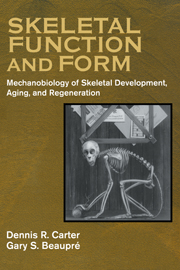Book contents
- Frontmatter
- Contents
- Preface
- Chapter 1 Form and Function
- Chapter 2 Skeletal Tissue Histomorphology and Mechanics
- Chapter 3 Cartilage Differentiation and Growth
- Chapter 4 Perichondral and Periosteal Ossification
- Chapter 5 Endochondral Growth and Ossification
- Chapter 6 Cancellous Bone
- Chapter 7 Skeletal Tissue Regeneration
- Chapter 8 Articular Cartilage Development and Destruction
- Chapter 9 Mechanobiology in Skeletal Evolution
- Chapter 10 The Physical Nature of Living Things
- Appendix A Material Characteristics
- Appendix B Structural Characteristics
- Appendix C Failure Characteristics
- Index
Chapter 4 - Perichondral and Periosteal Ossification
Published online by Cambridge University Press: 11 January 2010
- Frontmatter
- Contents
- Preface
- Chapter 1 Form and Function
- Chapter 2 Skeletal Tissue Histomorphology and Mechanics
- Chapter 3 Cartilage Differentiation and Growth
- Chapter 4 Perichondral and Periosteal Ossification
- Chapter 5 Endochondral Growth and Ossification
- Chapter 6 Cancellous Bone
- Chapter 7 Skeletal Tissue Regeneration
- Chapter 8 Articular Cartilage Development and Destruction
- Chapter 9 Mechanobiology in Skeletal Evolution
- Chapter 10 The Physical Nature of Living Things
- Appendix A Material Characteristics
- Appendix B Structural Characteristics
- Appendix C Failure Characteristics
- Index
Summary
Bone Formation
The flat bones of the skull and face are formed by intramembranous ossification within a condensation of cells derived from the neural crest. In the limb bones and most of the postcranial skeleton, however, mesenchymal cell condensations chondrify, creating the endoskeletal cartilage anlagen. These cartilage rudiments form the templates of the future skeleton and subsequently, in the process of growth, undergo a bony transformation.
The anlagen of the skeleton in early development are small, avascular rudiments consisting of chondrocytes surrounded by an extracellular matrix (Figure 3.13). The largest and most mature chondrocytes in most rudiments are found in the central region of the diaphysis. The cells in the center are surrounded by more extracellular matrix than those at the rudiment ends, leading to a low cell density. In most rudiments this area becomes the center of growth and ossification.
Cartilage growth occurs by mitosis, a net increase in the amount of extracellular matrix, and an increase in cell size. In the end stages of growth in a cartilage region, the cells hypertrophy and die as the extracellular matrix is calcified and then replaced by well-vascularized bone tissue. The cartilage cells within the rudiments therefore undergo a characteristic process of cell proliferation, maturation, hypertrophy, and death, followed by matrix calcification and ossification. Variations in the cartilage growth and ossification rates in different directions within the anlage result in shape changes of developing bones.
Five different phases of cartilage growth and differentiation during long bone ossification were described by Streeter (Streeter, 1949) (Figure 4.1).
- Type
- Chapter
- Information
- Skeletal Function and FormMechanobiology of Skeletal Development, Aging, and Regeneration, pp. 73 - 105Publisher: Cambridge University PressPrint publication year: 2000

